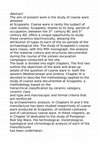Papers by Margherita Bergamini
Annali Della Facolta Di Lettere E Filosofia 1 Studi Classici, 1983

Abstract
The aim of present work is the study of coarse ware attested
at Scoppieto. Coarse ware ... more Abstract
The aim of present work is the study of coarse ware attested
at Scoppieto. Coarse ware is rarely the subject of case studies. Scoppieto, thanks to its long period of occupation, between the 3rd century BC and 5th century AD, offers a unique opportunity to study these ceramics diachronically, allowing the attribution of types to each of the six periods of the archaeological site. The study of Scoppieto’s coarse ware closes, with this fifth monograph, the analysis of the material culture and structures documented during the course of the sixteen excavation campaigns conducted at the site.
The book is divided into eight chapters. The first two outline the objectives of the work and draw up astate of the question of coarse ware in both the western Mediterranean and Umbria. Chapter III is devoted to describe the methodology applied to the study of coarse ware documented at Scoppieto, a methodology based on the
hierarchical classification by ceramic category, ceramic class
and type and macroscopic and formal criteria that are reinforced
by archaeometric analysis. In Chapters IV and V the manufacture has been studied respectively of coarse ware produced at Scoppieto, of oxidized cookware and of calcareous coarse ware. In these chapters, as in Chapter VI dedicated to the study of Pompeian Red Slip Ware, the technological, morphological, typological and chronological analysis of each of the manufactures
has been undertaken.
Finally, in Chapter VII, the coarse ware has been analyzed
in the archaeological context of Scoppieto through issues such as
the production of these ceramics at the archaeological site and the
evolution of the types of coarse ware from the republican
period to the change of the era, the most frequent forms of ceramics
during the 1st and 2nd centuries AD and the typological changes that took place from the 4th and 5th century AD, with shapes and types that became popular during the late-antique period, and the early Middle Ages. The relationship between coarse ware and other productions documented on the site, such as terra sigillata, has been studied in this section, through the six periods of Scoppieto. This last chapter also serves as a conclusion to reflect on the origin, transmission and craft traditions, as well as the eating habits at Scoppieto and in its surrounding area. Chapter VIII concludes this work with the results of the archaeometric analysis applied to calcareous coarse ware and oxidized cookware.
The book is complemented by more than forty figures
and plates displaying drawings and photographs of the ceramic material analysed, in order to facilitate and complete the reading of
this monograph.
M. BERGAMINI (a cura di), Scoppieto IV/1. I Materiali. Terra sigillata decorata a rilievo, Testi di Cristina Troso e Valentina Dezza, con il contributo di Massimo Oddone, Edizioni Quasar, Roma 2014., May 30, 2014

The archaeological field work and the study of the materials have allowed the periodization of th... more The archaeological field work and the study of the materials have allowed the periodization of the occupation of the site. Eight periods have been recognized, six ancient and two modern and contemporary (v. Table 1). The study of the numismatic finds, the amphorae and the wares imported from Africa was particularly useful, permitting the end of the ancient frequentation of the site to be dated to the mid 5th century AD.
The functional destination of the structures changes in the various periods and can be recognized in the modifications to the buildings in the course of the centuries. They can be synthesized as follows:
Period I (late 4th(?) – late 2nd/beginning of the 1st century BC): cult.
Period II (late 2nd/beginning of the 1st century BC – Augustan period): agricultural-craft.
Period III (Augustan – Trajanic period): manufactory.
Period IV (Hadrianic period – mid 3rd century AD): residential with craft and agricultural activities.
Period V (second half of the 3rd century AD): abandonment.
Period VI (4th – mid 5th century AD): residential with craft and agricultural activities.
Period VII (6th –18th centuries): sporadic frequentation.
Period VIII (19th – 20th centuries): agricultural activities
Excavations carried out in Scoppieto (Umbria), in the town council of Baschi, on the left banks o... more Excavations carried out in Scoppieto (Umbria), in the town council of Baschi, on the left banks of the Tiber, are bringing to light important structures related to a settlement belonging to the pre-Roman (from the end of the IV century BC) and Roman Age (till the half of the V century AD). The excavations are in progress. The archaeological research project, begun in 1995 by the University of Perugia (direction M. Bergamini). Eight periods have been identified and in the Period III, from the middle Augustan reign to Trajan age, the settlement was occupied by a pottery factory devoted mainly to the production of terra sigillata vessels and lamps

Coins founded in Scoppieto.
The 178 coins found cover the entire chronological range of the life... more Coins founded in Scoppieto.
The 178 coins found cover the entire chronological range of the life of the site and offer a reliable picture of monetary circulation in the various periods. The most frequent coins are those of the 1st century AD (= 31.46% of the total), which together with those of Trajan (2.81%) represent 34.27% of the total and belong to Period III (Augustan-Trajanic period) during which the pottery manufactory was active in the production of fine wares (terra sigillata), thin-walled wares and lamps. They can be explained by commercial exchanges connected with buying and selling. The coins of Period VI (4th – mid 5th century AD) , when the site had a residential use with handicraft and agricultural activities, follow in quantity with 32.58% of the total. The remaining 33.22% is distributed among Periods I (late 4th? – late 2nd/early 1st century BC) and II (late 2nd/early 1st century BC – Augustan period) with 15.73%, Period IV (Hadrianic period – mid 3rd century AD) with 12.92% and Period VIII (19th and 20th centuries) with 2.25%. Unidentifiable emissions account for 2.25%. The total lack of coins from Period V (second half of the 3rd century AD), corresponding to an abandonment phase of the site shown by collapses of the masonry structures, is extremely significant.
Objects and implements for working and firing clay
Among the material discovered by the excavati... more Objects and implements for working and firing clay
Among the material discovered by the excavation, these objects constitute a particularly important category, both for their quantity and for the heterogeneity of the types. The spacers and supports come exclusively from stratigraphic units of Period III (Augustan-Trajanic times) and therefore concern the activity of the pottery manufactory. The vault pots are documented also in layers of the republican period and show that the covering of the kilns in Period II (late 2nd/early 1st century BC – Augustan period) used this system. The discovery of utensils for working pottery and structural parts of a foot wheel is extremely interesting.
From archeeological research at Scoppieto (Baschi- prov. Terni) Central Italy










Uploads
Papers by Margherita Bergamini
The aim of present work is the study of coarse ware attested
at Scoppieto. Coarse ware is rarely the subject of case studies. Scoppieto, thanks to its long period of occupation, between the 3rd century BC and 5th century AD, offers a unique opportunity to study these ceramics diachronically, allowing the attribution of types to each of the six periods of the archaeological site. The study of Scoppieto’s coarse ware closes, with this fifth monograph, the analysis of the material culture and structures documented during the course of the sixteen excavation campaigns conducted at the site.
The book is divided into eight chapters. The first two outline the objectives of the work and draw up astate of the question of coarse ware in both the western Mediterranean and Umbria. Chapter III is devoted to describe the methodology applied to the study of coarse ware documented at Scoppieto, a methodology based on the
hierarchical classification by ceramic category, ceramic class
and type and macroscopic and formal criteria that are reinforced
by archaeometric analysis. In Chapters IV and V the manufacture has been studied respectively of coarse ware produced at Scoppieto, of oxidized cookware and of calcareous coarse ware. In these chapters, as in Chapter VI dedicated to the study of Pompeian Red Slip Ware, the technological, morphological, typological and chronological analysis of each of the manufactures
has been undertaken.
Finally, in Chapter VII, the coarse ware has been analyzed
in the archaeological context of Scoppieto through issues such as
the production of these ceramics at the archaeological site and the
evolution of the types of coarse ware from the republican
period to the change of the era, the most frequent forms of ceramics
during the 1st and 2nd centuries AD and the typological changes that took place from the 4th and 5th century AD, with shapes and types that became popular during the late-antique period, and the early Middle Ages. The relationship between coarse ware and other productions documented on the site, such as terra sigillata, has been studied in this section, through the six periods of Scoppieto. This last chapter also serves as a conclusion to reflect on the origin, transmission and craft traditions, as well as the eating habits at Scoppieto and in its surrounding area. Chapter VIII concludes this work with the results of the archaeometric analysis applied to calcareous coarse ware and oxidized cookware.
The book is complemented by more than forty figures
and plates displaying drawings and photographs of the ceramic material analysed, in order to facilitate and complete the reading of
this monograph.
The functional destination of the structures changes in the various periods and can be recognized in the modifications to the buildings in the course of the centuries. They can be synthesized as follows:
Period I (late 4th(?) – late 2nd/beginning of the 1st century BC): cult.
Period II (late 2nd/beginning of the 1st century BC – Augustan period): agricultural-craft.
Period III (Augustan – Trajanic period): manufactory.
Period IV (Hadrianic period – mid 3rd century AD): residential with craft and agricultural activities.
Period V (second half of the 3rd century AD): abandonment.
Period VI (4th – mid 5th century AD): residential with craft and agricultural activities.
Period VII (6th –18th centuries): sporadic frequentation.
Period VIII (19th – 20th centuries): agricultural activities
The 178 coins found cover the entire chronological range of the life of the site and offer a reliable picture of monetary circulation in the various periods. The most frequent coins are those of the 1st century AD (= 31.46% of the total), which together with those of Trajan (2.81%) represent 34.27% of the total and belong to Period III (Augustan-Trajanic period) during which the pottery manufactory was active in the production of fine wares (terra sigillata), thin-walled wares and lamps. They can be explained by commercial exchanges connected with buying and selling. The coins of Period VI (4th – mid 5th century AD) , when the site had a residential use with handicraft and agricultural activities, follow in quantity with 32.58% of the total. The remaining 33.22% is distributed among Periods I (late 4th? – late 2nd/early 1st century BC) and II (late 2nd/early 1st century BC – Augustan period) with 15.73%, Period IV (Hadrianic period – mid 3rd century AD) with 12.92% and Period VIII (19th and 20th centuries) with 2.25%. Unidentifiable emissions account for 2.25%. The total lack of coins from Period V (second half of the 3rd century AD), corresponding to an abandonment phase of the site shown by collapses of the masonry structures, is extremely significant.
Among the material discovered by the excavation, these objects constitute a particularly important category, both for their quantity and for the heterogeneity of the types. The spacers and supports come exclusively from stratigraphic units of Period III (Augustan-Trajanic times) and therefore concern the activity of the pottery manufactory. The vault pots are documented also in layers of the republican period and show that the covering of the kilns in Period II (late 2nd/early 1st century BC – Augustan period) used this system. The discovery of utensils for working pottery and structural parts of a foot wheel is extremely interesting.
The aim of present work is the study of coarse ware attested
at Scoppieto. Coarse ware is rarely the subject of case studies. Scoppieto, thanks to its long period of occupation, between the 3rd century BC and 5th century AD, offers a unique opportunity to study these ceramics diachronically, allowing the attribution of types to each of the six periods of the archaeological site. The study of Scoppieto’s coarse ware closes, with this fifth monograph, the analysis of the material culture and structures documented during the course of the sixteen excavation campaigns conducted at the site.
The book is divided into eight chapters. The first two outline the objectives of the work and draw up astate of the question of coarse ware in both the western Mediterranean and Umbria. Chapter III is devoted to describe the methodology applied to the study of coarse ware documented at Scoppieto, a methodology based on the
hierarchical classification by ceramic category, ceramic class
and type and macroscopic and formal criteria that are reinforced
by archaeometric analysis. In Chapters IV and V the manufacture has been studied respectively of coarse ware produced at Scoppieto, of oxidized cookware and of calcareous coarse ware. In these chapters, as in Chapter VI dedicated to the study of Pompeian Red Slip Ware, the technological, morphological, typological and chronological analysis of each of the manufactures
has been undertaken.
Finally, in Chapter VII, the coarse ware has been analyzed
in the archaeological context of Scoppieto through issues such as
the production of these ceramics at the archaeological site and the
evolution of the types of coarse ware from the republican
period to the change of the era, the most frequent forms of ceramics
during the 1st and 2nd centuries AD and the typological changes that took place from the 4th and 5th century AD, with shapes and types that became popular during the late-antique period, and the early Middle Ages. The relationship between coarse ware and other productions documented on the site, such as terra sigillata, has been studied in this section, through the six periods of Scoppieto. This last chapter also serves as a conclusion to reflect on the origin, transmission and craft traditions, as well as the eating habits at Scoppieto and in its surrounding area. Chapter VIII concludes this work with the results of the archaeometric analysis applied to calcareous coarse ware and oxidized cookware.
The book is complemented by more than forty figures
and plates displaying drawings and photographs of the ceramic material analysed, in order to facilitate and complete the reading of
this monograph.
The functional destination of the structures changes in the various periods and can be recognized in the modifications to the buildings in the course of the centuries. They can be synthesized as follows:
Period I (late 4th(?) – late 2nd/beginning of the 1st century BC): cult.
Period II (late 2nd/beginning of the 1st century BC – Augustan period): agricultural-craft.
Period III (Augustan – Trajanic period): manufactory.
Period IV (Hadrianic period – mid 3rd century AD): residential with craft and agricultural activities.
Period V (second half of the 3rd century AD): abandonment.
Period VI (4th – mid 5th century AD): residential with craft and agricultural activities.
Period VII (6th –18th centuries): sporadic frequentation.
Period VIII (19th – 20th centuries): agricultural activities
The 178 coins found cover the entire chronological range of the life of the site and offer a reliable picture of monetary circulation in the various periods. The most frequent coins are those of the 1st century AD (= 31.46% of the total), which together with those of Trajan (2.81%) represent 34.27% of the total and belong to Period III (Augustan-Trajanic period) during which the pottery manufactory was active in the production of fine wares (terra sigillata), thin-walled wares and lamps. They can be explained by commercial exchanges connected with buying and selling. The coins of Period VI (4th – mid 5th century AD) , when the site had a residential use with handicraft and agricultural activities, follow in quantity with 32.58% of the total. The remaining 33.22% is distributed among Periods I (late 4th? – late 2nd/early 1st century BC) and II (late 2nd/early 1st century BC – Augustan period) with 15.73%, Period IV (Hadrianic period – mid 3rd century AD) with 12.92% and Period VIII (19th and 20th centuries) with 2.25%. Unidentifiable emissions account for 2.25%. The total lack of coins from Period V (second half of the 3rd century AD), corresponding to an abandonment phase of the site shown by collapses of the masonry structures, is extremely significant.
Among the material discovered by the excavation, these objects constitute a particularly important category, both for their quantity and for the heterogeneity of the types. The spacers and supports come exclusively from stratigraphic units of Period III (Augustan-Trajanic times) and therefore concern the activity of the pottery manufactory. The vault pots are documented also in layers of the republican period and show that the covering of the kilns in Period II (late 2nd/early 1st century BC – Augustan period) used this system. The discovery of utensils for working pottery and structural parts of a foot wheel is extremely interesting.
This volume is dedicated entirely to the plain Italian Sigillata produced in the manufactory of Scoppieto, which was located in the middle Tiber Valley, in modern-day Umbria, and was active between the reigns of Augustus and Trajan. Part I presents the typological repertoire of the ware (including completely new types), the workshops that were active (identified by means of the analysis of the stamps), and the geographic area of distribution of the vessels. Furthermore, some questions are addressed concerning the organization and commercialization of the products, and the results of the archaeometric studies carried out on a sample of the pieces are illustrated. Starting from the supposition that the manufactory of Scoppieto was not the only production center in Tiberine Umbria (even if it is the one for now that has provided the most data), an attempt is made to reconstruct the productive panorama of the territory during the imperial period by means of an examination of the literary sources and archaeological documentation (represented mostly by ceramic finds). It was rather variegated and lively precisely because it gravitated toward the Tiber Basin and was therefore in direct connection with Rome, which was the main market for its products. Part II analyzes the plain products with applied relief decoration, which are outstanding for their variety and refinement. The complete repertoire of the decorative motifs used in the manufactory and their occurrence on the various vessel shapes are presented. Not a few plaque moulds (together with dies) from which the appliqués were obtained have been found. Thanks to archaeometric analyses, we know that they were imported in part from Arezzo and in part produced in the manufactory. They show the potential of a productive structure that was able to manage the entire productive cycle, helped in the commercialization of its products by its fortunate location near the river route of the Tiber, which guaranteed a direct connection with the Urbs.
I – Obiettivi e limiti del lavoro
II – Lo studio delle ceramiche comuni nel Mediterraneo occidentale e nell’Umbria
III – Metodologia applicata
IV – Ceramica da cucina ossidante
V – Ceramica comune calcarea
VI – Ceramica a vernice rossa interna
VII – Lo studio delle ceramiche comuni nel contesto archeologico di Scoppieto
VIII – Ceramica da cucina ossidante e ceramica comune calcarea: analisi archeometriche
Bibliografia
Tavole